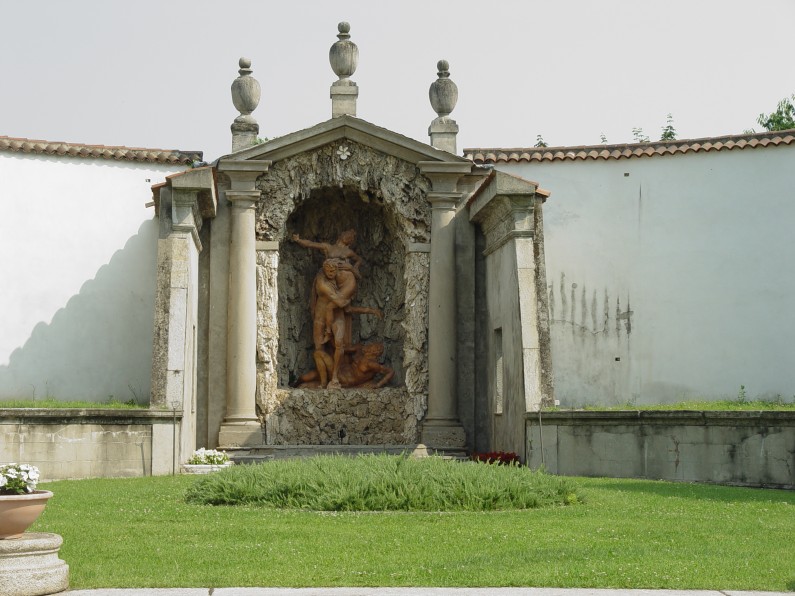
The terracotta work is positioned inside a large travertine niche, housed in a faux aedicule in gray limestone and placed at the end of the garden of the Nymphaeum, which is the endpoint of the south-north axis orienting the whole complex of the Villa.
More
It portrays a young man raising above his head, a naked girl who tries to wriggle her way out by throwing her head back and raising her arm in the air, while the other hand tries to loosen the hold of her captor. Squatting on the ground, under the man’s legs, is another male figure that tries to hold the girl by squeezing her ankle. The group sculpture depicts the “Rape of the Sabine Women,” one of the oldest legends related to the history of Rome; according to the legend, Romulus turned to the people who lived close to Rome to form alliances and obtain women with whom to populate the new city. He was rejected, so he decided to organize a great show to attract the inhabitants of the city in Lazio, during which the women were captured. The men were driven away and they left Rome vowing revenge.
The same women who were kidnapped later stopped the war that ensued, particularly with the population of the Sabines; they begged the men to stop the bloody confrontation and lay the foundations for peace, launching the union between the two peoples with common power and citizenship. The identification of the characters represented here in this episode would explain the presence of an apparently older man at the foot of the kidnapper, and who could have been identified as the father of the girl. In fact, according to Plutarch, Romulus and his troops only kidnapped unmarried women, while the historian, Livy, says that violence was not used on them and that Romulus offered to girls full civil and property rights in the fledgling city.
This sculpture seems to have borrowed heavily from the more celebrated sculpture with the same name of Giambologna collocated under the Loggia dei Lanzi in the Piazza della Signoria/Signoria Square in Florence dated 1583; however, the characters and their accentuated expressive naturalism also refers to the sculptural tradition of Lombardy. Because of this way of thinking, critics have given two different attributive hypotheses. A first moves towards the little-known sculptor from Pavia, Roger Bascapè (d. 1600), a pupil of Francesco Brambilla who is considered the “director” of all sculptural creations present in the Villa. The second shifts the focus on the French sculptor, Pierre Francheville (1553-1616), who learned the Mannerist style in Florence right at the workshop of the Flemish master, Giambologna.
Whatever the origin of the sculptor, it is very likely that Pirro I Visconti Borromeo wanted to make sure that his artistic collection included smaller sculptures in marble or glazed bronze, which gave witness to the importance of Giambologna’s works. Therefore, the sculptor of this “Rape of the Sabine Women” had direct contact with the works of the master.
The same women who were kidnapped later stopped the war that ensued, particularly with the population of the Sabines; they begged the men to stop the bloody confrontation and lay the foundations for peace, launching the union between the two peoples with common power and citizenship. The identification of the characters represented here in this episode would explain the presence of an apparently older man at the foot of the kidnapper, and who could have been identified as the father of the girl. In fact, according to Plutarch, Romulus and his troops only kidnapped unmarried women, while the historian, Livy, says that violence was not used on them and that Romulus offered to girls full civil and property rights in the fledgling city.
This sculpture seems to have borrowed heavily from the more celebrated sculpture with the same name of Giambologna collocated under the Loggia dei Lanzi in the Piazza della Signoria/Signoria Square in Florence dated 1583; however, the characters and their accentuated expressive naturalism also refers to the sculptural tradition of Lombardy. Because of this way of thinking, critics have given two different attributive hypotheses. A first moves towards the little-known sculptor from Pavia, Roger Bascapè (d. 1600), a pupil of Francesco Brambilla who is considered the “director” of all sculptural creations present in the Villa. The second shifts the focus on the French sculptor, Pierre Francheville (1553-1616), who learned the Mannerist style in Florence right at the workshop of the Flemish master, Giambologna.
Whatever the origin of the sculptor, it is very likely that Pirro I Visconti Borromeo wanted to make sure that his artistic collection included smaller sculptures in marble or glazed bronze, which gave witness to the importance of Giambologna’s works. Therefore, the sculptor of this “Rape of the Sabine Women” had direct contact with the works of the master.
